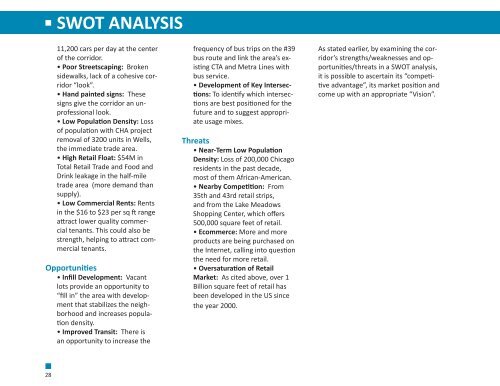East 39th Street Commercial Corridor Plan by Chris Devins
Street Commercial Corridor Plan is a comprehensive commercial real estate development plan that envisions the future of the East 39th Street Commercial Corridor and the surrounding 2 mile trade area in Chicago, based on current demographic, real estate market, zoning, land use, political and commercial business data. For more visit Chris Devins Creative on the web. https;//chrisdevinscreative.com
Street Commercial Corridor Plan is a comprehensive commercial real estate development plan that envisions the future of the East 39th Street Commercial
Corridor and the surrounding 2 mile trade area in Chicago, based on current demographic, real estate market, zoning, land use, political and commercial business data. For more visit Chris Devins Creative on the web. https;//chrisdevinscreative.com
Create successful ePaper yourself
Turn your PDF publications into a flip-book with our unique Google optimized e-Paper software.
SWOT ANALYSIS<br />
11,200 cars per day at the center<br />
of the corridor.<br />
• Poor <strong>Street</strong>scaping: Broken<br />
sidewalks, lack of a cohesive corridor<br />
“look”.<br />
• Hand painted signs: These<br />
signs give the corridor an unprofessional<br />
look.<br />
• Low Population Density: Loss<br />
of population with CHA project<br />
removal of 3200 units in Wells,<br />
the immediate trade area.<br />
• High Retail Float: $54M in<br />
Total Retail Trade and Food and<br />
Drink leakage in the half-mile<br />
trade area (more demand than<br />
supply).<br />
• Low <strong>Commercial</strong> Rents: Rents<br />
in the $16 to $23 per sq ft range<br />
attract lower quality commercial<br />
tenants. This could also be<br />
strength, helping to attract commercial<br />
tenants.<br />
Opportunities<br />
• Infill Development: Vacant<br />
lots provide an opportunity to<br />
“fill in” the area with development<br />
that stabilizes the neighborhood<br />
and increases population<br />
density.<br />
• Improved Transit: There is<br />
an opportunity to increase the<br />
frequency of bus trips on the #39<br />
bus route and link the area’s existing<br />
CTA and Metra Lines with<br />
bus service.<br />
• Development of Key Intersections:<br />
To identify which intersections<br />
are best positioned for the<br />
future and to suggest appropriate<br />
usage mixes.<br />
Threats<br />
• Near-Term Low Population<br />
Density: Loss of 200,000 Chicago<br />
residents in the past decade,<br />
most of them African-American.<br />
• Near<strong>by</strong> Competition: From<br />
35th and 43rd retail strips,<br />
and from the Lake Meadows<br />
Shopping Center, which offers<br />
500,000 square feet of retail.<br />
• Ecommerce: More and more<br />
products are being purchased on<br />
the Internet, calling into question<br />
the need for more retail.<br />
• Oversaturation of Retail<br />
Market: As cited above, over 1<br />
Billion square feet of retail has<br />
been developed in the US since<br />
the year 2000.<br />
As stated earlier, <strong>by</strong> examining the corridor’s<br />
strengths/weaknesses and opportunities/threats<br />
in a SWOT analysis,<br />
it is possible to ascertain its “competitive<br />
advantage”, its market position and<br />
come up with an appropriate “Vision”.<br />
28


